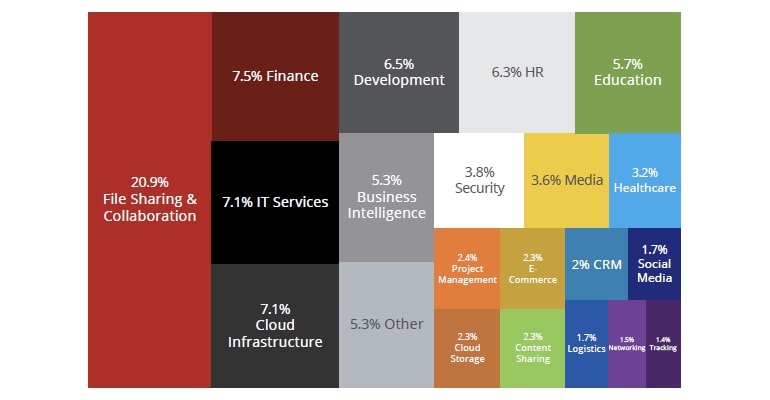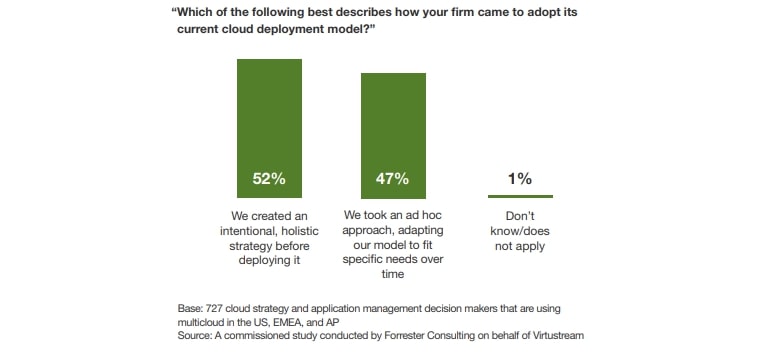What is multi-cloud?
A practical solution to a complex problem

A multi-cloud approach is one in which a business uses more than one cloud platform or application, each for a specific purpose. This includes the best cloud storage platforms, applications like Slack, productivity suites like Microsoft 365 or Google Workspace, and other services including Amazon Web Services and Microsoft Azure.
Unsurprisingly, the vast majority of businesses - whether they realize it or not - have adopted this method, using a combination of public (and sometimes private) cloud environments in day-to-day operations. In this article, we’ll take a closer look at multi-cloud environments, and the most common advantages and challenges associated with them.
Why do businesses use multi-cloud environments?
Most businesses adopt a multi-cloud approach because no single, perfect solution is known to them (or even likely to exist). To understand why, let’s take a closer look at cloud computing in general.
Cloud computing can be divided into three main categories: infrastructure as a service (IaaS); platform as a service (PaaS); and software as a service (SaaS).
IaaS, the most basic level, provides a nearly empty virtual environment for businesses to build custom solutions. It’s theoretically possible to build a single solution that addresses all aspects of a business’s operations, but it would be extraordinarily complex, costly, and difficult to maintain.

Unable or unwilling to invest in such a huge undertaking, most businesses thus prefer to use a combination of IaaS, PaaS, and SaaS to meet business objectives. PaaS and SaaS providers offer lower-level solutions: platforms dedicated to a particular objective and software that responds to specific needs, like communication and collaboration.
Rather than building everything from the ground up, companies prefer to pick and choose from different cloud solutions, cobbling them together to achieve certain goals, and thus making use of a multi-cloud environment. A company that uses Slack for communication, Microsoft 365 for collaboration, Sage for accounting, and Bamboo for human resources and payroll is one that has adopted a multi-cloud approach.
Sign up to get the BEST of Tom's Guide direct to your inbox.
Get instant access to breaking news, the hottest reviews, great deals and helpful tips.
Additionally, different departments and locations which work semi-independently are likely to adopt different cloud services based on their needs (or simple familiarity). This is well demonstrated by a 2019 McAfee report in which 1,400 IT professionals were asked how many cloud services their company used. The average response was 34. The actual number, on average, was 1,935.

Multi-cloud should not be confused with a hybrid cloud solution, in which a business uses both public cloud services in conjunction with a private, “on-premises” cloud of their own. A private cloud follows the same principles as a public one, except that users - and especially the business’s customers - do not interface with it directly. Instead, information is exchanged between private and public clouds, the latter of which is customer-facing.
A hybrid cloud environment is thus characterized by the integration of public and private cloud platforms, while a multi-cloud approach refers principally to the use of multiple public cloud platforms by a single business.
What are the advantages of using a multi-cloud approach?
There are a few important advantages to a multi-cloud environment. One of the most obvious is the flexibility that comes with combining different cloud platforms rather than placing all of one’s eggs in a single basket, as it were. You avoid being “locked in” with a single vendor, and thus being limited by its strengths and weaknesses.
Of course, this also gives leverage to businesses when negotiating with vendors. The former are free to compare providers and products, and the latter are highly incentivized to provide an industry-leading product at competitive rates. A business with a multi-cloud environment can more easily change service agreements than one whose mission-critical functions are tied into a single platform.
A multi-cloud environment also enables businesses to add and remove functions and applications as needed. Thus, as departments grow or are added and missions change, a business can simply add a new cloud service to fulfill this need. This also adds in scalability, as a company can swap vendors if they outgrow a smaller one.
What challenges do multi-cloud environments pose to businesses?

Of course, the many moving parts associated with a multi-cloud environment mean that there are more opportunities for something to go wrong. While in principle different platforms and applications should work together seamlessly, this is not always the case.
Thus, the demands on IT professionals can be extreme as different departments, locations, and even individuals adopt different solutions (the average company in McAfee’s survey made use of more than 1,900 different cloud services).
These inconsistencies can have important and far-flung consequences on workflow and management, as well. Different teams may use different software to achieve the same ends, thus making it difficult to streamline practices company-wide. File and data sharing also suffer, as different service agreements result in discrepancies in versioning and file history, the size of files that can be uploaded or manipulated, and even how files are read or acted upon.
Unsurprisingly, all of this complicates training as well, and makes it more difficult to ensure regulatory compliance. Major skill gaps can develop between staff in different departments or locations. Furthermore, the number of different platforms in use is inversely proportional to the number of skilled applicants available for hire.
Security is another important concern. First, different cloud environments may adopt different security measures of greater or lesser strengths, and finding weaknesses in a multi-cloud environment is much more difficult than on a single, unified platform.
Patching those weaknesses is more difficult, as well - a correction on one platform may break an important integration or disrupt a critical workflow. Multiple environments can also mean multiple passwords, encouraging employees to adopt poor password habits.
Many of these challenges can be mitigated or avoided entirely by carefully planning out one’s multi-cloud environment: that is, by deciding what functions are needed, researching a variety of providers that claim to meet these needs, and determining how well they will work in concert.
Unfortunately, according to a study by VirtuStream, only a narrow majority of businesses have taken this approach. Research has shown that 47% add cloud platforms and applications in an ad-hoc manner, opening the door to imperfect integrations and many of the challenges cited above.
Conclusion
Despite the challenges posed by multi-cloud environments, most businesses still choose to adopt this approach. This is partly due to the advantages associated with such an environment, but also because it’s tremendously difficult to find (or expensive to create) a single solution that responds to every aspect of a business’ operations.
Multi-cloud environments, in which a variety of cloud applications and platforms are used together to achieve business objectives, enable businesses to grow and adapt to customer needs. If you're interested in finding out more, read our feature that explains why a multi-cloud strategy benefits businesses.
Christian is a freelance writer and content project manager with over six years' experience writing and leading teams in finance and technology for some of the world's largest online publishers, including TechRadar and Tom's Guide.

